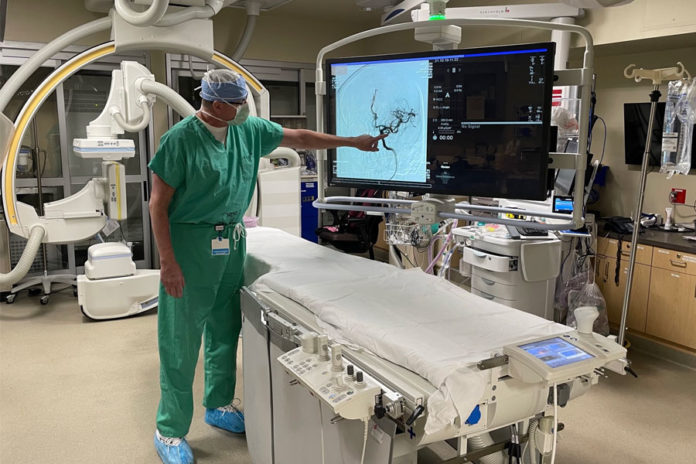You or a loved one are not feeling well. Maybe you are experiencing sudden vision loss or weakness in one or both arms. You may wonder if it is serious and what to do. Should you go to the Emergency Department or wait, and see? You may be having a stroke and if that is the case, every minute counts.
Jorge Eller, M.D., who is an endovascular neurosurgeon at AtlantiCare Regional Medical Center (ARMC) and specializes in cerebrovascular and endovascular neurosurgery emphasizes that “if you are not sure of what is going on, you are better off calling 911 and being checked at the hospital than waiting.” During a stroke, a portion of the brain stops getting the needed blood supply potentially killing the cells and tissue in the area. Therefore, timely treatment is essential. “No other condition is as time sensitive because the brain starts to die very quickly. The quicker a diagnosis is made, and treatment is started the higher the chances of reversing the symptoms” he says.
The doctor explains that statistically, every minute that passes without treatment causes the patient to accelerate their age by three weeks, and to lose over five days of healthy life. In one minute, a patient can lose 1.9 million neurons (brain cells) and 14 billion synapses (connections between cells). That is why his team at AtlantiCare uses “Rapid Artificial Intelligence Technology”. After a patient undergoes tests such as CT scans and angiograms, the results are analyzed by the software which sends an alarm to all the team members letting them know if the tests revealed an occlusion as well as the viability of the tissue in the affected area. Everyone in the team, nurses, doctors, technicians in the Intervention Room and the Emergency Department, receives the notification at the same time, mobilizing quickly and saving precious minutes. In the last year, since they started using this technology, the number of patients undergoing successful revascularizations (allowing for blood flow back to the affected area) has increased from 79% to 90%. In general, his team has been able to reduce the time from arrival at the emergency department to treatment by 44 precious minutes.

Strokes are more prevalent than we realize, with about 850,00 cases per year. Symptoms vary depending on the vessel that is affected. One way to think of possible symptoms of a stroke is using the acronym “BE FAST” on the side panel. Dr. Eller recommends that a patient with these symptoms call 911 and wait for an ambulance instead of being driven to the hospital by a loved one, since the paramedics can start treating the patient on their way to the hospital. ARMC Atlantic City Campus is a comprehensive stroke center and therefore has a neurointensive care unit, and can provide advanced diagnostics, specialized treatment and treat multiple patients at the same time.
As we’ve mentioned in previous articles, diabetic patients are at an increased risk for cardiovascular disease and stroke. To minimize risks, patients are encouraged to change their lifestyle to include exercise, and a healthy diet. Patients should receive treatment to control their diabetes and if also diagnosed with high blood pressure or cholesterol, take steps to reduce it. Patients should also stop smoking. Dr. Eller notes that since COVID, they are seeing younger patients developing hypercoagulable conditions and coming in with thrombus and strokes. These patients are in their twenties and thirties.

According to the Center for Disease Control and Prevention, stroke is the fourth leading cause of death for Hispanics living in the United States, and Hispanics have different risk factors for strokes. Compared to non-Hispanic whites, Hispanics have strokes at younger ages. The average age for a stroke among non-Hispanic whites is 80, but among Hispanics living in the United States, it’s 67. Dr. Eller says that there can be a cultural discomfort among Latinos with being in the hospital or seeking healthcare services in general. He says AtlantiCare’s team focuses on breaking down barriers to care, including language, and on ensuring all individuals get the primary and specialty care they need. “That care includes recognizing the unique needs of each patient and encouraging and helping individuals to access care. Having regular primary and specialty care visits to prevent, diagnose, and treat chronic conditions that can lead to stroke, including high blood pressure, high cholesterol, and heart disease, is so important.”
The key message, he concludes, is that there is a small window of time and that is the time for the patient to get to the hospital. The window is different for each patient, so it is important to call 911 immediately for emergency response and transport to the hospital. He says refrain from driving yourself or a loved one.























